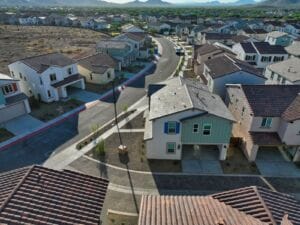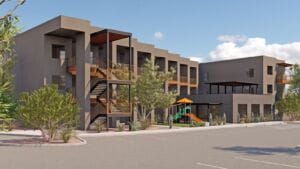This past decade has transformed the relationship between America and its housing, especially when it comes to renting. While the recession pushed many to rent out of necessity, the economic expansion which followed, coupled with changing attitudes towards family and homeownership, lead to the rise of the renter by choice. Rentership rates expanded across the board—from young families to seniors, from city cores to suburbs, many Americans have shifted away from homeownership.
Here are the decade’s highlights for Phoenix:
• In the past decade, the Phoenix Metro area saw a positive net migration of 42,000 renters. This means more people came to the Valley to rent, compared to those that left. Los Angeles is the main contributor to this migration, with almost 12,000 movers.
• To accommodate the incoming renters, between 2010-2019, Phoenix Metro area built some of the largest stocks of new apartments in the US. Over 50,000 new units were delivered in the past decade, pushing the Valley of the Sun on the 12th position nationally.
• Phoenix isn’t complete without its neighboring suburbs. Suburban renting gained momentum in the past decade and Phoenix makes no exception. Its suburbs added 32% more renters, while the urban core added 22% more. The city ranks second place nationally, based on suburban renting increase.
• Renting over the age of 60 is another rising habit we saw in the past decade. Phoenix is the fourth city by increase in the 60+ segment, as it saw 68% more renters in this age group move in. Numerically, over 18,000 renters aged 60+ moved in in the past decade, second only to Houston, where the number was almost 27,000.
Developers across the U.S. responded to the demand in rentership with a construction boom unseen since the 1980s, which includes a growing number of high-end units. Meanwhile, apartment buildings themselves have become increasingly sophisticated, to accommodate quality-seeking lifestyle renters.
This past decade, the research team at RENTCafé continually analyzed housing trends and released several reports on major directions in renting. Now, as we have reached the end of these tumultuous but prolific ten years, researchers gathered the most significant insights discovered and updated them. Utilizing data from the U.S. Census Bureau, Yardi Matrix, PropertyShark, and the U.S. News & World Report, RENTCafé researchers examined a number of economic and demographic indicators to get an overview of the housing trends that shaped the country in the past ten years.
1. The national average rent increased by 36% in the past decade
Since 2010, the national average rent increased by $390 or 36%, propelled by increasingly valuable land, progressively sophisticated apartments, and a booming job market that pushed demand skywards. The median home price went up by 31% in the same timeframe, while the median household income grew by 27%. Private college tuition fees were also on the rise—the price of higher education increased more than housing costs, shooting up by 39% in the past decade.
2. The number of American renters surpassed 100 million this decade
The renter population has become more than 100M strong after a decade of sustained growth. The number of Americans who rent reached 108.5M in 2018, up from 99.4M in 2010. At the same time, the share of renters now makes up 34% of the general population and is the largest it’s been since 1960, when 36% of Americans were tenants. By comparison, there were 202M homeowners in 2018, up from 189M in 2010.
Although the percentage of renters in the general population fluctuated throughout the years, its growth has been consistent since the 2000s. There are 74% more renters today than there were in 1960, with their numbers swelling by 46M since then.
3. The renter population grew twice as fast as the owner population
On a national level, renting shot up in popularity in the past decade. Since 2010, the number of renters increased two times faster (+9.1%) than the number of homeowners (+4.3%), signaling a considerable shift in the American lifestyle.
Overall, the share of renters went up by a full percentage point, from 33% to 34% of the U.S. population. And although only one-third of Americans are renters, 9.1M began renting in the past decade, considerably more than the 8.7M who purchased homes.
4. Renters became the majority population in 20 cities in the past decade
California and Texas both saw three cities switch to a renter majority, the most out of any other states present in the ranking. However, Toledo, OH, posted the most significant gains in its renter segment, which went up by 23% in the past decade.
5. More high-earning Americans are renting than ever
Nationally, the number of households earning more than 150k per year who rent increased two times faster (+157%) than the number of high-earning homeowner households (+78%) since 2010, as progressively more wealthy Americans choose renting over homeownership.

An increasing number of Americans are renting as a lifestyle option—its easier to move neighborhoods or cities when you’re not tied down to a mortgage. However, since home prices upsurged in the nations’ priciest cities, lack of affordability also plays a role. While 150k translates differently depending on where you live, the number of high-earning renter households at least doubled in a significant 46 of the nation’s 50 largest cities. At the same time, five cities had a majority of renters earning over 150k a year in 2018, up from two in 2010.
Overall, more than half of the top 20 cities which registered the highest increases in wealthy renters saw the number of high-earning renters at least quadruple. Arlington, TX (x6.5) leads the ranking and is the only metro where the number of high-earning renters multiplied more than six times.






